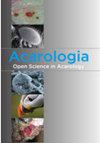中国栗球羽螨两新种(Acarina:Psoroptidia)——栗球羽蛛(雀形目:扁蛛科)
IF 0.9
3区 农林科学
Q3 ENTOMOLOGY
引用次数: 0
摘要
本文报道了我国1870年采集到的两种新的寄主灰蝶(Pycnonotidae)羽螨:球斑蝶(Trouesartia bulbulbuli sp.nov.)和广东翼龙(Pteronyssidae)。球藻属Trouessartia bulbuli sp.nov.与T.latisetata Gaud,1952相似,不同之处在于具有以下特征:球藻雄性胫骨IV在solenidiaφ的基部具有顶端棘状突起,外膜IVa较宽,前端有不规则形状的小延伸;雌性的交配开口在叶间膜边缘的宽角小突起(外交配管)上,h1刚毛呈丝状。广东Pteroherpus Guangdong ensis sp.nov.属于hoplophorus物种群,最接近P.meghalayensis Constantinescu,2014。该新种具有以下独特特征:雄性有一个很长的生殖器官和具有长分支的外掌,延伸到刚毛4a的基部之外,在前盾后面有一对小的额外硬骨,正面盾形为不规则形状的小的纵向硬骨片;雌性的子宫体屏障分为不成对的哑铃形子宫前部巩膜、三角形中央巩膜、成对的侧部子宫体巩膜和乳头状巩膜(类似于hoplophorus群的其他物种),子宫颈腺开口gl位于有条纹的被盖上。本文章由计算机程序翻译,如有差异,请以英文原文为准。
Two new feather mite species (Acarina: Psoroptidia) from the Chestnut Bulbul, Hemixos castanonotus (Passeriformes: Pycnonotidae), in China
Two new species of feather mites from the bird host Hemixos castanonotus Swinhoe, 1870 (Pycnonotidae) collected in China are described: Trouessartia bulbuli sp. nov. (Trouessartiidae) and Pteroherpus guangdongensis sp. nov. (Pteronyssidae). Trouessartia bulbuli sp. nov. is close to T. latisetata Gaud, 1952 and differs in having the following features: in males of T. bulbuli tibia IV has apical thorn-like process at base of solenidia φ, epimerites IVa are wide and with a small extension of irregular form on the anterior end; in females, the copulatory opening is on the small wide-angular projection (external copulatory tube) on the margin of interlobar membrane and h1 setae are filiform. Pteroherpus guangdongensis sp. nov. belongs to the hoplophorus species group and is most close to P. meghalayensis Constantinescu, 2014.The new species has the following distinctive characters: in males, a very long genital apparatus and the epiandrum with long branches, extending beyond the base of setae 4a, a pair of small additional sclerites posterior to prodorsal shield is present, and adanal shield is shaped as a small longitudinal sclerite of irregular form; in females, the hysterosomal shield is split into unpaired anterior hysteronotal sclerite shaped as shaped as dumb-bell, central sclerite of triangular form, paired lateral opisthosomal sclerites and pygidial sclerites (similar to those in other species of hoplophorus group), and the hysteronotal gland openings gl are situated on the striated tegument.
求助全文
通过发布文献求助,成功后即可免费获取论文全文。
去求助
来源期刊

Acarologia
ENTOMOLOGY-
CiteScore
2.00
自引率
18.20%
发文量
81
期刊介绍:
Acarologia is a free open-access journal. Please help us by submitting manuscripts in accordance with following instructions.
All manuscripts which do not conform to the instructions will be returned to authors without the benefit of review.
Acarologia publishes the results of original research on all aspects of Acarology.
The journal policy is that taxonomic descriptions should include several species within a same genus/family, when possible.
The editors reserve the right to refuse manuscripts when authors intentionally divide individual species descriptions of the same genus/family into distinct publications.
Single species descriptions should be clearly justified based on their scientific interest.
 求助内容:
求助内容: 应助结果提醒方式:
应助结果提醒方式:


